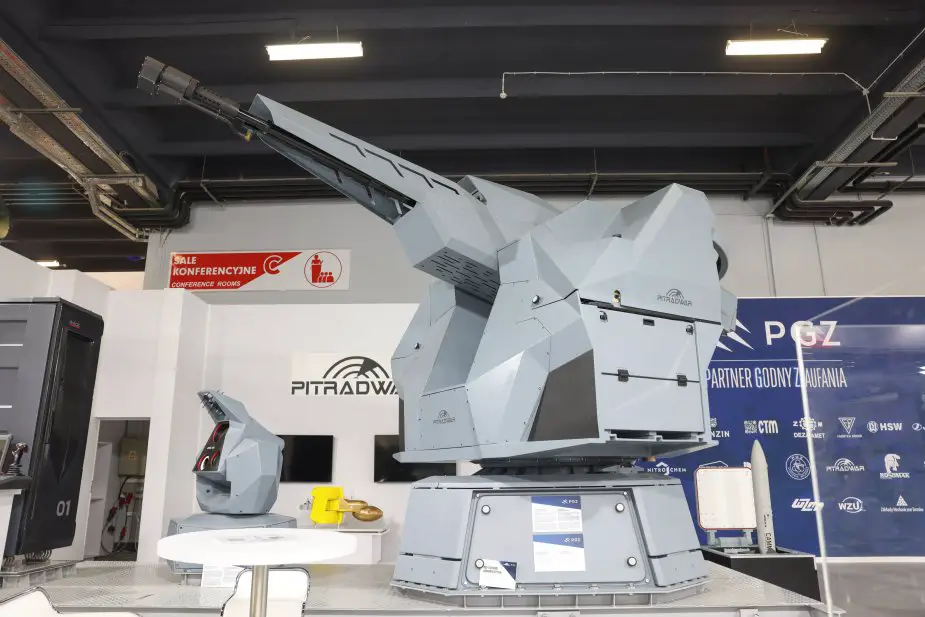Breaking news
PGZ to deliver three OSU-35K naval guns to the Polish Navy.
According to a tweet published by PGZ on September 19, 2022, PGZ has awarded a contract for the purchase and delivery of three OSU-35K Ship Armament Systems (Kormoran II project). The value of the contract is more than PLN 100 million gross.
Follow Navy Recognition on Google News at this link
 OSU-35K Ship Weapons System (Picture source: PGZ)
OSU-35K Ship Weapons System (Picture source: PGZ)
The OSU-35K Ship Weapons System is a modern, effective, remote, multi-task anti-aircraft artillery direct defense system equipped with the 35 mm automatic gun having its own optoelectronic fire control system.
It enables combating various types of threats while ensuring high precision of attack range. It is intended for combat operations day and night, in all weather conditions in which naval vessel with OSU-35K thereon is operating.
It was designed both for cooperation with the ship combat management system (CMS) and for autonomous operation, independently of the CMS system.
The innovative construction of the entire system and its components using carbon fiber technology ensured that the optimum weight (little more than 3 tonnes) and dimensions as well as high level of ergonomy were achieved.
The low weight makes it possible to be mounted on any platform, also small ones and weight sensitive. The modularity of the system allows its integration on various ships.
The system is composed of: the AM-35K automatic cannon, ZGS-35K integrated tracking head, BSKO-35K fire control system block, and RSKO-35K reserve fire control post.
The OSU-35K combats airborne targets maneuvering course, velocity, and altitude in the zone of fire and also seaborne targets. The system has the capability to detect, track and combat airborne targets such as aircraft, helicopters, unmanned aerial vehicles, or missiles of unarmoured or lightly armored surface targets and targets in asymmetric operations.
The Qualification Studies of the system confirmed its feasibility to combat the targets at a distance up to 5500 m and on the level up to 3500 m (depending on the ammunition used) at rapid firing rates of 550 projectiles per minute. The ammunition is supplied on the opposite sides of the gun by two belt tracks, each of the security magazines containing 100 pcs of ammunition.
The system of programmable dismantled ammunition being developed within the PIT-RADWAR Consortium in cooperation with MESKO enables controlled dismantling of a projectile in a specific moment of its flight (after pre-programmed time following firing) which raises the effectiveness of fighting the target. The projectile is programmable without contact while going through the discharge device mounted at the end of the barrel.
Fire control system (Pol. SKO) may operate in an automatic or semi-automated mode. In case the SKO system is out of the fight or if data from the detection system are missing, RSKO-35K reserve fire control post (optional) may be utilized which by taking over basic functions such as controls or tracking ensures control over the effector.
The OSU-35K system is equipped with the ZGS-35K integrated tracking head fitted with precise electric drives which together with the modern stabilization system of sensor line of sight and that of the cannon barrel aiming line provide for very high dynamics while maintaining high precision of movement. Stabilization enables precise effective firefighting on the move in extremely variable maritime environment.
The OSU-35K system may operate both during the day and night owing to the ZGS-35K sensors built in the head (infrared camera 3–5 μm, daylight camera, high repetition laser rangefinder). Interrogator IFF operating in Mode 5 (Mark XIIA) may also be integrated with the above system.
The system also makes use of the PIT-RADWAR designed SOWA video tracker providing for effective and reliable tracking of detected objects, in difficult and different conditions.
New functionality implemented in the system as automatic multi-channel tracking of objects allows for continuous tracking of the target without the operator’s need to switch between available sensors (cameras).
The implemented innovation dramatically increases the efficiency of automatic tracking which is critical for the advanced modern fire control systems dedicated to being mounted in the Air Defense Systems (for all air attack means [Pol. ŚNP] including mini/micro unmanned aerial vehicles [Pol. BSP]) and also in the automated land and marine systems.




























